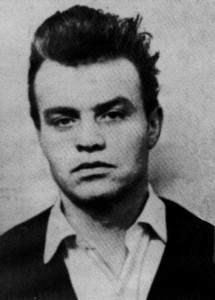
In June 1969 an advert appeared in the local papers for a rented room at 14 Holyrood Crescent in Glasgow’s popular West End. The Crescent had been built during the expansion of the 19th century, when Glasgow’s middle classes were moving west. By the 1960’s the imposing townhouses had been divided up into bedsits and provided accommodation for a more transient clientele.
In response to the advert, a seemingly respectable young man giving his name and occupation as Mr J. Douglas, Antiques Dealer rented the room for 7 guineas a week.
The caretaker, Mrs Teresa Austin, impressed by his perfect manners and immaculate dress sense, had no inkling of the events that would unfold just 3 weeks later when the quiet, residential street would resemble a scene from a Hollywood crime movie, and a New-York style police car chase would take place across the west end and the north of the city.
The seemingly respectable “antiques dealer” was 34 year old James Griffiths from Rochdale in Lancashire, whose brushes with law had begun at the age of 10 when he appeared before a juvenile court for being “beyond control”. In early 1969 he had been released from his most recent spell in prison after serving 6 years for robbery with violence.
On the morning of Tuesday 15 July the police arrived at his door. They wanted to ask Griffiths a few questions about his connections with another criminal. Griffiths however, had a pathological fear of being returned to prison, having spent 17 of the last 25 years in institutions, approved schools, borstals and prisons. He started firing shots at the police. As the officers quickly retreated DC William Walker (28) was shot in the back .

Griffiths then appeared at the attic window, firing shots at anything that moved. Police blocked off the area and the siege continued with police reinforcements arriving, including police marksmen.
As police prepared to use tear gas the heavily-armed gunman escaped via the back garden and ran through the old Coopers tea factory. A man sitting in his car outside the Grapes public house in Henderson St. was shot through the car window and dragged from the car. Griffiths then jumped into the car and drove off towards Possil.

He crashed the car in Carnbroe St. and burst in to the nearby Round Toll bar. A 65 year old local man, William Hughes, was standing drinking at the bar. As he raised his pint glass to his lips the gunman swung round and shot him. The manager, James Connolly, grabbed Griffiths by the shoulders and threw him out the front door. Just then a lorry pulled up and the driver got out to see what was happening, having heard the bang. Griffiths jumped in lorry and pulled off, still firing, while the driver took cover.
By this time the police were in pursuit and Griffiths headed towards Springburn, an area with which he was unfamiliar. Turning into Kay St and discovering it was a cul de sac, he abandoned the lorry and ran in to the close at number 26 and up to the top flat. He shot the lock off the door and entered the flat – thankfully nobody was at home – and from the window he began firing into the street which was quickly cleared by police. The gunman then sent a spray of bullets into a children’s playground at the back of the building. The police entered the building and the gunman was shot dead a few minutes later by Chief Superintendent Malcolm Finlayson.
By that time thirteen innocent people ranging in age from 17 to 65 had been shot and required hospital treatment. William Hughes, who had been shot in the Round Toll bar died from his injuries a few days later.
A few months later the Lord Advocate ruled that there would be no public inquiry into the gunman’s death: that the police had taken the necessary steps in a difficult and dangerous situation, and acted with a proper regard to the public interest, He said that they also acted with commendable courage. Chief Superintendent Finlayson and several other police and civilians were awarded the Glasgow Corporation Medal for Bravery.
James Griffiths is buried in an unmarked grave in Linn Cemetery. None of his family attended his funeral.
The Glasgow Police Museum at 30 Bell Street in the Merchant City has an interesting display of photographs and artefacts relating to this incident.
